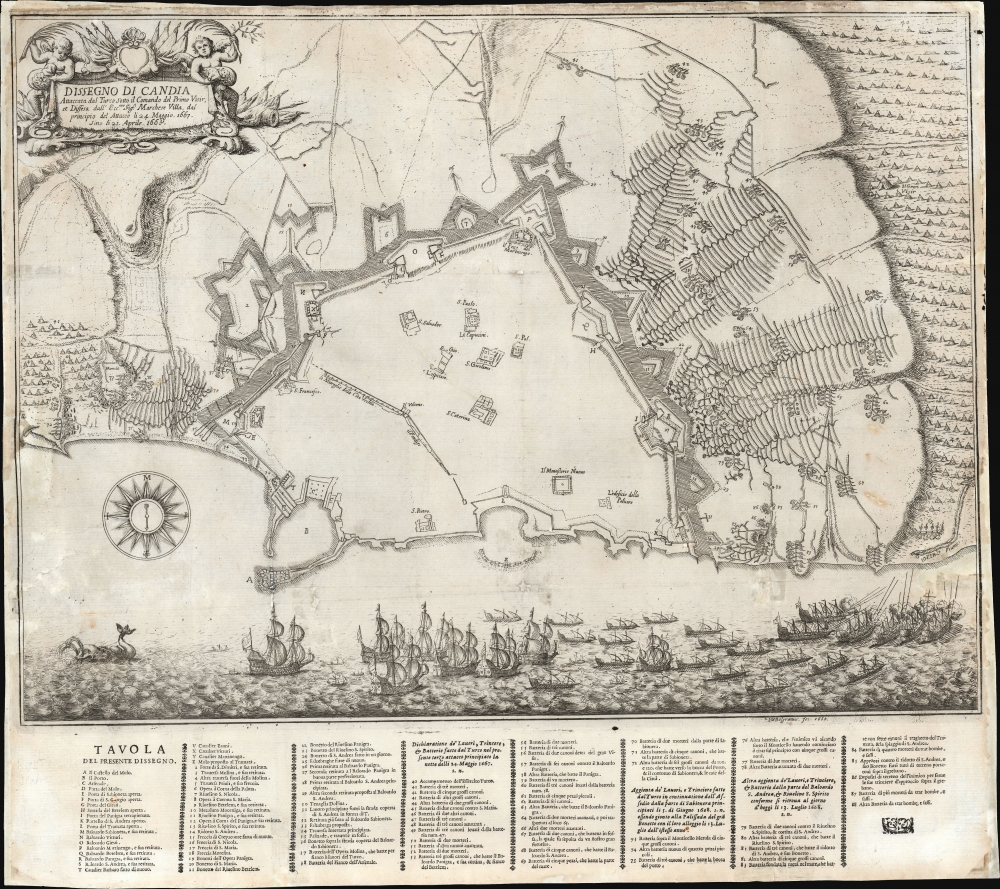1668 Belgrano / Rostagno Plan of Candia, Crete during the Great Siege of the City
Candia-belgrano-1668$3,000.00

Title
Dissegno di Candia Attaccata dal Turco SAotto il Comando del Primo Visir, et Diffesa dall' Eccmo. Sigr. Marchese Villa, dal principio dl Attacco li 24 Maggio, 1667. Sino li 21 Aprile 1668.
1668 (dated) 17.5 x 19.5 in (44.45 x 49.53 cm)
1668 (dated) 17.5 x 19.5 in (44.45 x 49.53 cm)
Description
This is an extremely rare 1668 plan of the port of Heraklion / Candia, Crete, illustrating the Venetian-controlled city during the final years of its 21-year-long Ottoman Siege. It is one of the only known works of the engraver Giovanni Maria Belgrano (fl. 1668-1680), who produced the work to accompany the rare first edition of Giovanni Battista Rostagno's (fl. 1668) travelogue based on his experience while he was a member of General Ghiron Francesco Villa's reconnaissance of Dalmatia and the Levant during the Cretan War. The present work was engraved in late 1668: the travelogue it appeared in was printed in Turin that same year. It is thus near contemporaneous the events depicted.
A Closer Look
The engraving - oriented to the south - is a detailed and dramatic plan of both the Venetian defenses of Heraklion and the situation of the surrounding Ottomans. Positions of interest, including the embattled city's harbor, specific bastions, the city arsenal, and so on, are labeled and keyed to the legend. Particular attention again is given to the flotilla of attacking the Turkish camp to the west of the city. The plan specifically references attacks from May 24, 1667 - April 21, 1668. It is accompanied by a table keying locations to letters and numbers on the plan itself; for the most part, these are fortifications. These are broken out to detail locations pertinent to the night of May 24, June 5, 1668, and July 13, 1668. Giovanni Battista Rostagno was secretary of state to Charles Emmanuel II, Duke of Savoy, and accompanied the Marquis Ghiron Francesco de Villa on his military service during the Cretan War, during which de Villa commanded the garrison at Candia between 1665 and 1668.The Longest Siege
The Ottoman siege of Venetian-ruled Candia was the second longest such battle in history, lasting twenty-one years. Beginning in 1648, a massive Ottoman army laid siege to the city, cutting off its water supply and constructing a sprawling earthwork encroaching on its walls (shown here). They then bombarded the city for the subsequent 16 years. The Venetians, in turn, blockaded the Dardanelles to prevent Ottoman resupply and reinforcement, leading to a series of naval battles. Over the course of the siege, forces from all over Europe and the Ottoman Empire were drawn into the fight, including the French, who sent soldiers to reinforce the Venetians throughout the 1660s. In 1669, Francois de Beaufort, son of the Duc de Vendôme, led a major effort to break the siege. Beaufort's campaign was a disaster: his flagship La Thérèse was destroyed in an accidental magazine explosion on June 24, and he was killed during a night sortie. Utterly demoralized by these blows, the French withdrew from Candia, leaving the Venetians no choice but to surrender the city in September 1669. Although the siege ended with the Ottoman capture of Candia, it was a Pyrrhic victory. The expense of the siege in men, money, and material was ruinous, and historians consider it to mark the decline of the Ottoman Empire.Publication History and Census
This work is extremely rare. It appeared only in the first edition of Rostagno's travelogue, published in Torino by Sinibaldo in 1668. We see perhaps 20 examples of the book in institutional collections; it has only appeared on the market a few times. We see a single institutional copy of the separate plan, at Princeton.Cartographer
Giovanni Maria Belgrano (fl. 1680 - 1688) was an Italian engraver active in the second half of the 17th century. Although evidently an accomplished artist, his name is attached to only a few works: a beautiful 1688 plan of Heraklion on Crete, and a magnificent 1680 map of the Piedmont authored by Giovanni Tommaso Borgonio (1620 - 1683). More by this mapmaker...
Source
Rostagno, G. B., Viaggi dell' illustrissimo, [et] eccellentissimo Sign. Marchese Ghiron Francesco Villa in Dalmatia, e Levante (Torino, Sinibaldi) 1668.
Condition
Good. Few areas of marginal restoration, with some areas of manuscript reinstatement to center left.
References
OCLC 76954845.

